This page is intended to be a resource to help people choose an appropriate packrafting paddle, and it’s a work in progress. The opinions expressed here are my own and your experience may differ. If you have a paddle that you like or dislike, please post a comment below. If possible, please include the brand, model, approximate price, weight, number of pieces the paddle breaks down into, what it’s made from, the type of paddling you use it for, and what you like/dislike about it. Thanks! -Matt
Introduction
Like a packraft and PFD, a paddle is one of those things you can’t packraft without, and the price of a paddle should be factored into your packrafting budget. Because packrafting is a relatively niche sport, packrafting-specific paddles are rare, with only a few companies marketing paddles explicitly to packrafters. In most cases, you’ll be searching for a kayak paddle (see the 2-Person Packraft section below for the exception).
The features that packrafters care about most in a paddle include weight, price, strength, durability, length, blade area, and the number of pieces the paddle breaks down into. Before we get into those things, however, let’s make sure we understand some paddle fundamentals:
High-Angle or Low-Angle Paddling?
If you do any research about kayak paddles, you will come across the terms “high-angle” and “low-angle” paddling. This diagram explains the difference pretty well, and the text indicates when each style is used:
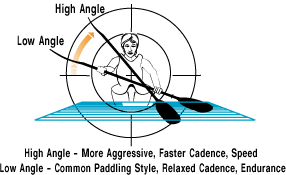
Notice that the paddler in the diagram is sitting in a very narrow kayak; packrafts are much wider than this, and the extra width forces you to adopt a relatively low-angle paddling style. You might still use high-angle strokes in whitewater or when battling stiff headwinds, but when shopping for a paddle, especially as a beginner, you can assume you’re a low-angle paddler.
Asymmetric paddle blade shape – which way is up?
Most kayak paddles have asymmetric blades.
The asymmetric shape isn’t just for looks – it minimizes the twisting force that is felt on the paddle when the blade is only partially submerged. We don’t need to go into the physics here, but you should at least know that if your paddle has asymmetric blades, the longer half goes on top – in other words, when you hold your paddle, the tip of the blade should be above the shaft’s centerline:
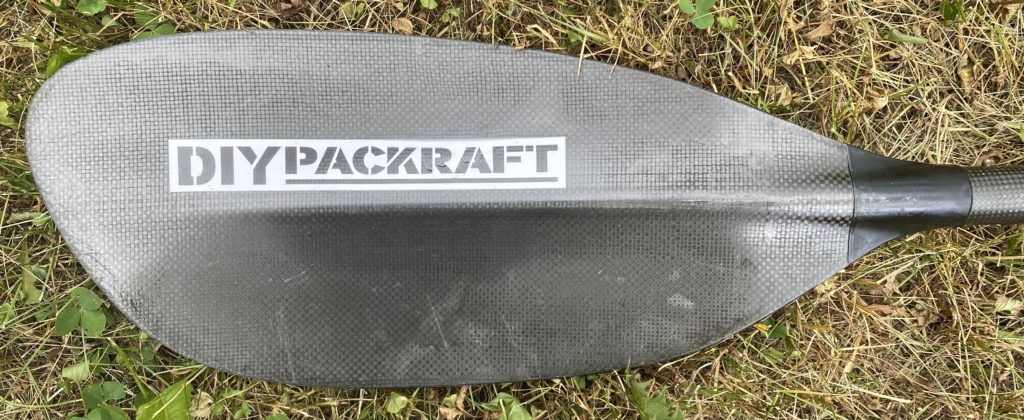
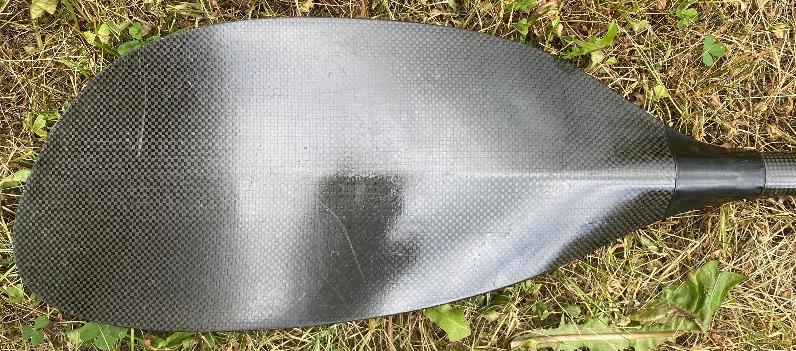
Front and back?

In addition to a top and bottom, most kayak paddle blades have a front and back. This is usually determined by some amount of concavity or dihedral (or a combination of both), which moves the center of pressure forward, making the paddle self-stabilizing in the water so you don’t feel it flutter back and forth. We don’t need to get into the physics of how this works, but you should be aware that the more concave side is designed to face backwards and catch the water during a forward stroke, like a spoon. When you paddle backwards, don’t flip the paddle around – push with the front face so you don’t have to change your grip.
Feather angle?


Nearly all kayak paddles allow the user to adjust the “feather” angle (the angle between the blades).
For most paddlers, the main benefit of feathering the blades is that it cuts down on wind resistance. If you doubt that this could affect your speed and endurance, go outside on a windy day and hold your paddle blade at various angles to the wind (it’s a bit like holding your hand flat out a car window and rotating it to feel the change in drag). Take note of the amount of force required to hold the blade flat against the wind, and then imagine someone constantly pushing against the front of your packraft with that same force as you try to paddle forward. Obviously the amount of drag you feel depends on the speed and direction of the wind, but paddling into a headwind is difficult enough already – you don’t need to make it any harder by using an unfeathered paddle.
Some paddles allow just a few feather angle options (such as unfeathered, left-handed, and right-handed) while others allow you to finely tune the feather angle to suit the conditions and your preferences.
To use a feathered paddle, you control the angle of the blades with your dominant hand and allow the paddle shaft to rotate freely in your non-dominant hand. When you make a stroke on your dominant side, your wrists are straight; as you finish that stroke and reach for a stroke on your non-dominant side, you rotate the paddle shaft with your dominant wrist by twisting it back towards you, in the same way you’d accelerate a motorcycle.
If you’re right-handed and you have to roll your right wrist forward to make the paddle work (away from you, as if you’re slowing a motorcycle), that means the feather angle is set for a left-handed paddler and it needs to be changed (and vice versa if you’re left-handed).
Paddling with feathered blades takes a while to get used to, but it quickly becomes second-nature and it’ll save you some energy whenever the wind is in your face.
If you find yourself paddling with a tailwind, unfeather the blades to take advantage of the extra push you’ll get from the wind against the blade that isn’t in the water.
Now that we’ve covered some of the basics, let’s get into the stuff that really matters:
Price
Paddle prices range from $20 for a two-piece paddle with an aluminum shaft and plastic blades to around $500 for some boutique carbon fiber models; generally, the more you pay, the lighter, stiffer, and stronger the paddle will be, and the smaller it can be disassembled for transport. If you’re just getting into the sport, don’t feel like you need to buy a top-of-the line paddle, as there are some budget options that might suit your needs very well. You probably won’t find a paddle that breaks down into more than two pieces for under $100 though.
One, Two, or Four-Piece Paddles
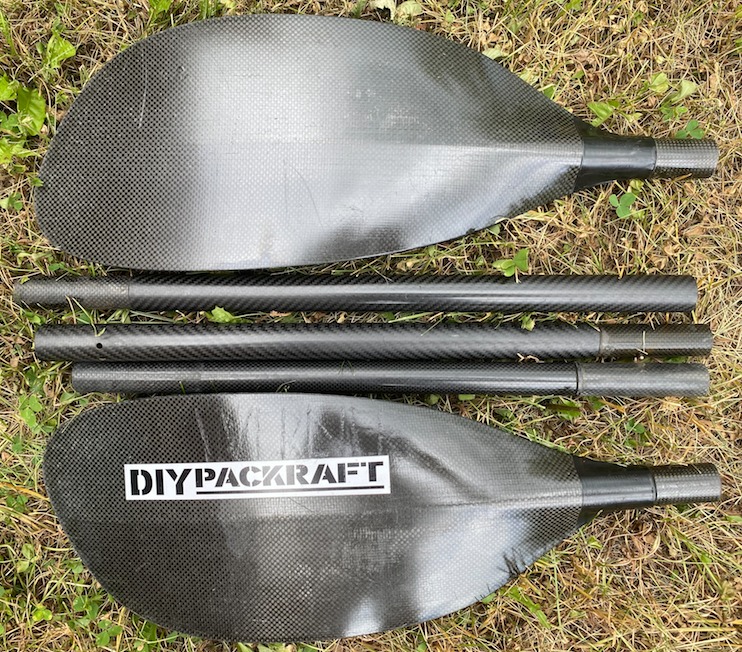
Long paddle pieces can be very annoying if you hike off trail through bushy or forested terrain, so if you intend to do that frequently, I highly recommend purchasing a four-piece paddle. (As far as I’m aware, three-piece paddles aren’t available anywhere – probably because the joints between the pieces would be located right where your hands grip the shaft.) Four-piece options are fairly common in mid- to high-price kayak paddles.
If you’re considering a four-piece paddle, be sure to check the length of the longest piece, because some four-piece paddles (such as the Werner Pack-Tour M) have three short pieces and one annoyingly long piece, which defeats the purpose of a four-piece paddle.
If you’re already a kayaker, you can use your regular paddle for packrafting. Because packrafts are significantly wider than kayaks, however, you might prefer one of a different length. If you’re a sea kayaker, you might prefer a paddle with larger blades than you’re used to because packrafts offer less resistance to your paddle strokes – due to their short length, light weight, and flat bottoms, packrafts yaw back and forth much more than sea kayaks, so you’ll need a larger blade or longer length to feel the same amount of feedback from the water.
Greenland-style paddles (with long, thin, tapering blades) are favored by many sea kayakers, and I have enjoyed using a Greenland paddle while packrafting in open water. The only drawback of Greenland blades is that they don’t shed water as well as wider blades, so if your paddle is too short and/or doesn’t have drip rings, water tends to flow along the shaft and drip into your packraft.
Paddle Weight
All else being equal, a lighter paddle is better than a heavier one, both on the water and off, but it’s hard to recommend a target weight for a packrafting paddle because the type of paddling you intend to do will determine how strong you need the paddle to be, and the materials it’s made from will determine a paddle’s strength-to-weight ratio (and price). A carbon fiber paddle might be the same weight as an aluminum and plastic paddle, but one will be much stronger than the other. Personally, I wouldn’t buy a paddle heavier than 1000 grams (35 oz), but I’m not much of a whitewater paddler. My modified carbon 5-piece paddle (see video below) weighs only 724 grams (25.5 oz) and it’s strong enough for my needs.
Paddle Length & Blade Size
The ideal paddle length is a matter of personal preference, and will depend on your body size, strength, paddling style, and your boat (especially its width and its resistance to yaw). You can find some paddle length charts and formulas online, but these are generally made for kayakers, so should only be used as a starting point. Because packrafts are wider than kayaks and yaw more easily, you may prefer a longer paddle than the charts indicate.
Some paddles have a telescoping section in the middle, allowing you to adjust the length somewhat to suit you (or multiple people).
In general, a longer paddle will offer more resistance to your strokes.
The size of a paddle’s blades will also affect the feel of the paddle, with larger blades offering more resistance to your strokes. Paddle blade area is usually given in square inches or square centimeters, but sometimes this information is missing from product descriptions.
Ideally, you’ll be able to try out a few paddles to determine what length and blade size combination feels most comfortable to you before you make a purchase, but don’t expect a paddle to feel the same in a packraft as it does in a sea kayak or other boat, because much of the feel of a paddle comes from the way the boat responds to it.
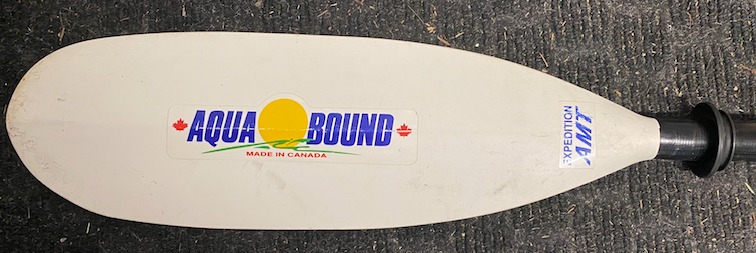
Materials
Fiberglass is a common material used to make both paddle shafts and blades. It’s strong and inexpensive, but not as strong as carbon fiber for a given weight.
Carbon fiber composites are extremely strong, stiff, and lightweight, but carbon paddles are expensive. Carbon fiber + epoxy is also not especially impact-resistant, so many carbon paddles have blades made from (or reinforced with) other materials so they can withstand more abuse.
Many carbon and fiberglass paddle blades are formed over a styrofoam core, which makes them stronger and prevents them from sinking if you drop them in the water.
Aluminum is commonly used to make inexpensive paddle shafts. Aluminum shafts aren’t ideal: they might stain your hands with grey aluminum oxide, they feel very cold in cool weather, and they might eventually crack from metal fatigue… but the price is unbeatable.
Along with an aluminum shaft, inexpensive paddles usually have blades made from plastic (such as ABS). These are strong enough for casual use, but not suitable for whitewater paddling as they are fairly flexible.
Paddles have been made from wood for thousands of years and canoe paddles are still commonly made from various softwoods. Wooden kayak paddles are rare, however, except for some lovely paddles with cedar-composite blades.
Paddle Brands & Models
Hopefully this list will grow as people contribute their knowledge; if you have experience with a paddle, please help others by leaving a comment below with any relevant information. The list is in no particular order.
Werner Pack-Tour M
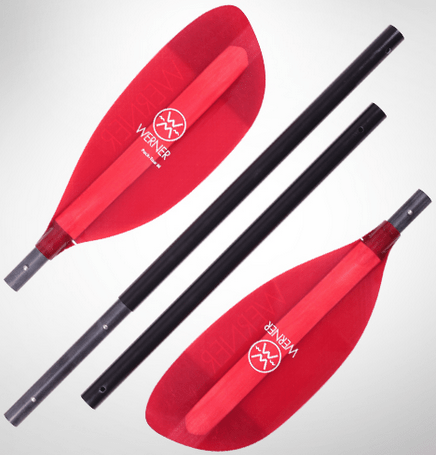
This four-piece paddle was a disappointment. Werner is a premium brand, and the paddle feels strong and stiff, but it’s very expensive, a bit heavy for packrafting, and one of the four pieces is much longer than the others (80 cm or 31″) – too long to pack in or on a backpack without sticking out, which makes it unsuitable for bushwhacking or airline travel.
Big-Box Store Paddles
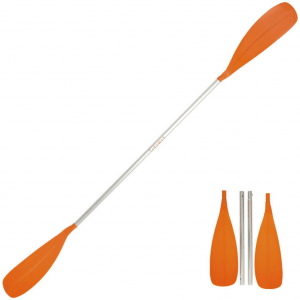
Many big-box stores sell inexpensive kayak paddles. Typically, these have a two-piece aluminum shaft with plastic blades and they are reasonably lightweight. They’re probably not strong enough for any sort of whitewater paddling, but would be a good first paddle, and at around $20, you can’t beat the price.
Some of these stores also sell inexpensive fiberglass paddles, which tend to be a bit heavy for packrafting, but if price is a major concern and you still want something fairly strong, these could be a good option.
Aqua-Bound Manta Ray
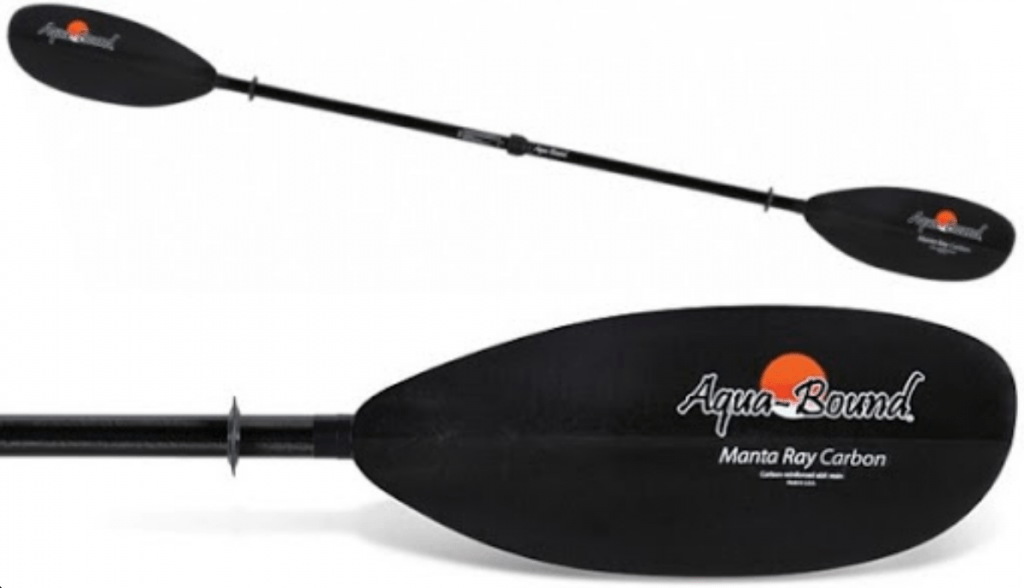
Aqua-Bound is a respected paddle brand, offering many mid-range to high-end models. I haven’t used the Manta Ray (available in glass or carbon, two or four pieces), but it looks like a great option. If I could trade my Pack-Tour M for a four-piece carbon Manta Ray, I would do it in a heartbeat, even though the Manta Ray is a less expensive paddle.
Info copied from the manufacturer’s site:
- Shaft Material: 100% Carbon
- Blade Material: abX Carbon Reinforced Nylon
- Blade Size: 7.25 x 18 in. (18 x 46 cm.)
- Blade Surface Area: 105 sq. in. (677 sq. cm.)
- Weight: 29.5 oz. (836 g)
- Ferrule Angles: 0° & 60° (L or R)
Aliexpress 4-Piece Carbon Paddles
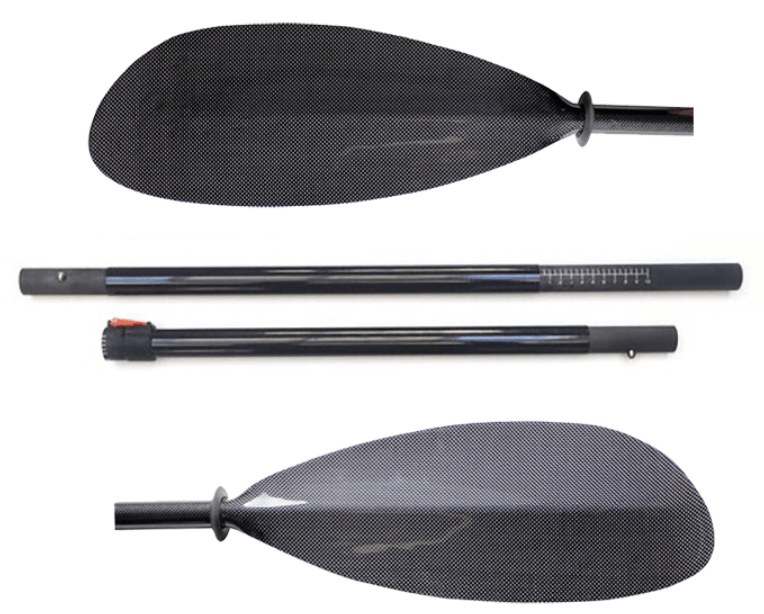
The Chinese direct-to-consumer sales site aliexpress.com sells a variety of kayak paddles, including some intriguing lightweight four-piece carbon models at relatively low prices (and sometimes they go on sale for significant discounts). I haven’t used one or spoken to anyone who has, so I can’t comment on the quality of the product or the purchasing experience, but I would be very interested to hear from someone who has. If I didn’t already own a lightweight carbon paddle (see below), I would probably take a gamble on one of these.
Advanced Elements Ultralite Pack Paddle

This paddle was recommended by Nathan A. It’s inexpensive, available on Amazon, lightweight (23.6 oz or 669 g) and 224 cm (88″) long. It packs down to 23.6″ (60 cm), and it has an aluminum shaft and polypropylene (plastic) blades. For light duty, this might be a good option. Some people have reported that it feels a bit flimsy and the blades are quite small. At least one person has bent this paddle in whitewater (see UtahBrian’s comment below).
ITIWIT Remo Carbon 5-Piece Paddle
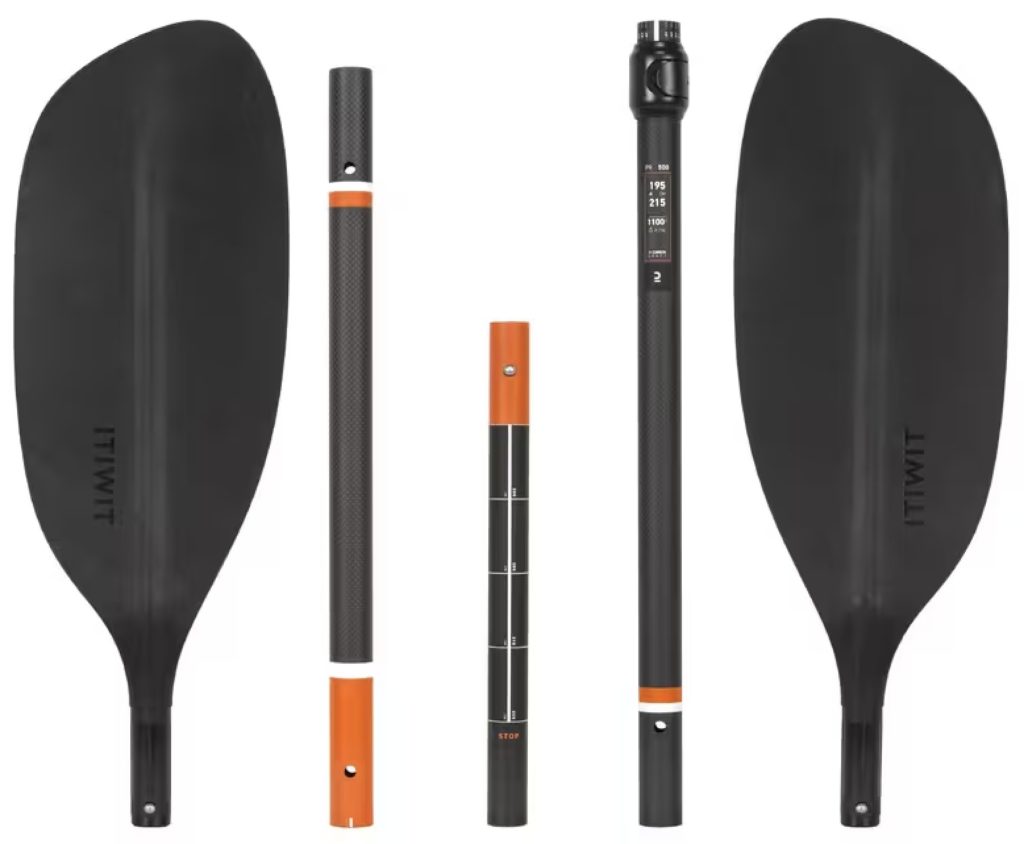
This paddle looks like a good option for people in Europe and was recommended by Borja in a comment below. It weighs 1 kg (2.2 lbs) and appears to be a great value.
Shearwater Webbed Paddle
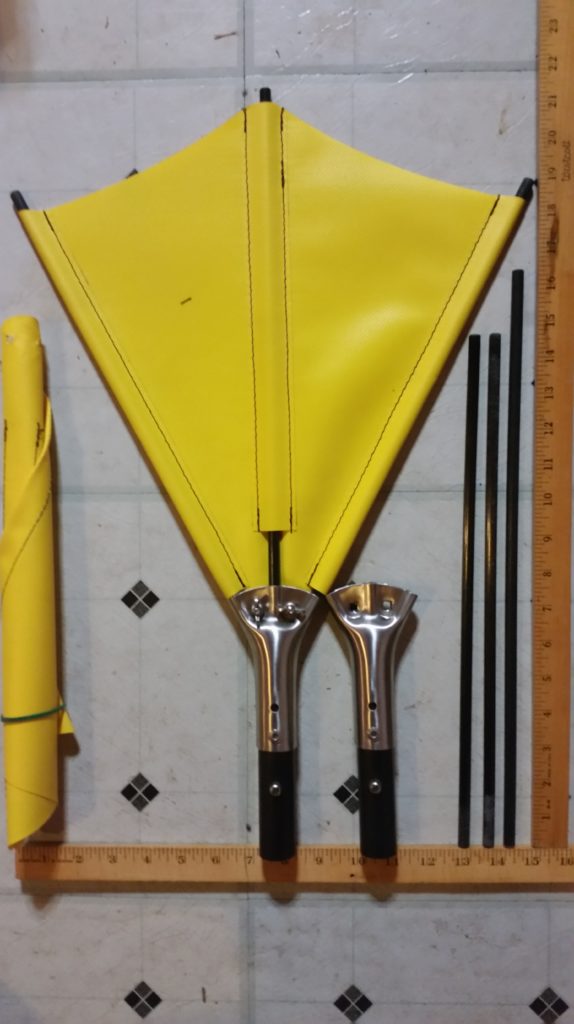
For the ultimate in collapsibility, consider a webbed paddle. These are custom made by Shearwater Webbed Paddles – search for them on Facebook or email Chad at shearwater@yahoo.com for details.
A DIY Paddle?
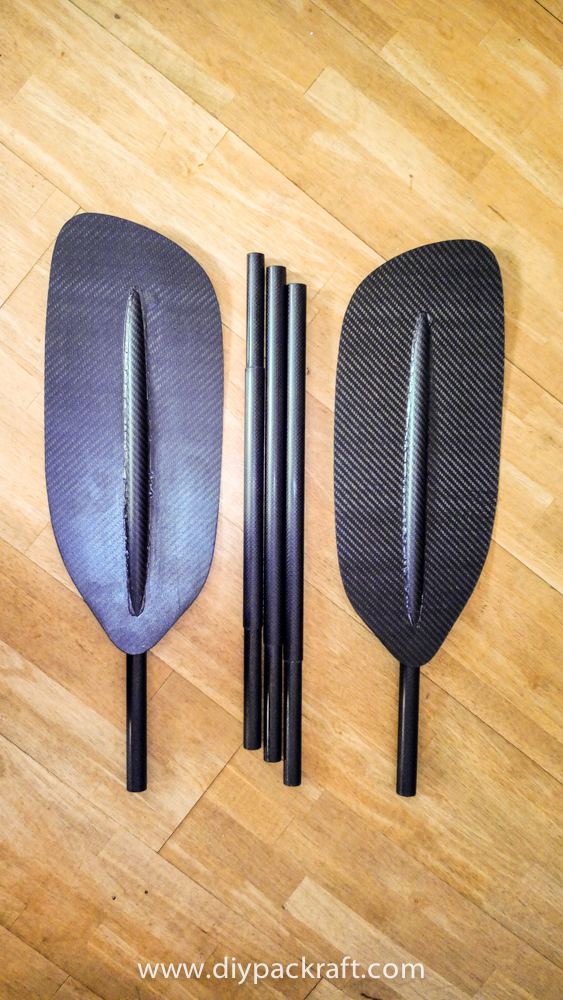
Several years ago I featured a DIY carbon paddle on the blog, made by a fellow in Germany named Andreas. Unfortunately, carbon fiber tubes and sheets are very expensive, so you won’t necessarily save money by building your own carbon paddle, but if you do choose to make one you’ll end up with exactly the features you want.
Instead of making one from scratch, you could convert an existing one-piece or two-piece paddle into a four- or five-piece paddle, as I did in the video below (but this won’t save you any money unless you already have a paddle you’re willing to cut apart or you can find a used one for a low price). I modified a lightweight bent-shaft model that my mother-in-law (an avid kayaker) purchased and eventually rejected, saying that using it felt like trying to paddle through ice cream.
Paddles for 2-Person Packrafts
For 2-person packrafts, you have the option of using two double-bladed kayak paddles or a pair of single-bladed canoe paddles. At least one paddle (the Aqua-Bound Shred Apart) converts from a double-bladed kayak paddle into two canoe paddles, so that might be a good option if you plan to switch back and forth between solo and tandem paddling.
Given the extra width and larger tube diameter of the 2-person packrafts, canoe paddles can be a better option than kayak paddles, especially if two people are paddling (choose long canoe paddles). This allows the paddlers to reach the water more easily, and unlike with a kayak paddle, you won’t have water dripping into the boat from the high blade.
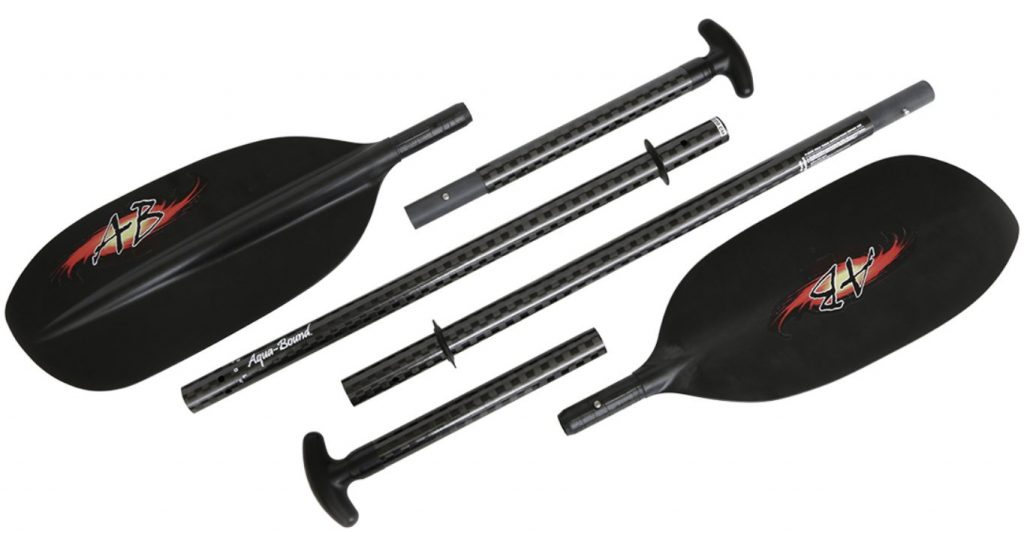
When I’m the sole paddler and I have a decent load in the 2-Person boat (such as a couple of kids or an adult passenger or lots of gear), I use a long kayak paddle and I sit on the rear tube instead of the seat. That allows me to reach the water with my paddle a bit more easily.
7 Comments
Borja · July 12, 2023 at 2:11 pm
Great review. Thanks.
Just a comment, when you say that “you may prefer a longer paddle because packrafts are wider than kayaks”, in my opinion is not exactly like that, specially for whitewater, sometimes you need to go through a narrow passage and shorter paddles are more confortable in order to don’t hit the stones. Furthermore, in packrafts you need shorter paddling to turn and you don’t need circular stroke for example, so maybe is enough with 195-205cm.
Look at this; French megastore Decathlon has always nice price for a medium+ quality: https://www.decathlon.es/es/p/remo-kayak-packraft-carbono-ajustable-desmontable-5-partes-190-210-cm/_/R-p-337851?mc=8733658&c=NEGRO
Chris · June 3, 2020 at 4:53 am
It is worth to mention for the folks here in Europe that there is an inexpensive option that comes from Germany. There is a cottage packraft manufacturer called Anfibio Packrafting. I bought their ultralight paddle the “Anfibio Fly”.
Weighting just 460 grams (verified) it is a adjustable length paddle and breaks down to 5 pieces, each 49 cm.
While it is not a full sized paddle it is a great paddle for ultralight packrafting hiking, does the job at low cost for 99 Euros. Would not bring it for real whitewater (maybe class I), but for lake crossings or slow rivers is perfect.
DISCLOSURE: I bought this paddle by own founds.
Brian · May 27, 2020 at 11:08 am
I bought the inexpensive Advanced Elements ultralight (680g, 1.5 lbs) and paddled through 80 miles of class II and class III whitewater with it. It’s a fine paddle and comes with nice drippers to keep your hands dry. When I carried it lashed to my pack broken down into 4 pieces, it survived ten miles of trees, brush, and off-trail conditions with ease.
I don’t know how it would do on real whitewater, but it feels solid. There is just enough play in the joints that you can tell it’s not one piece when you’re paying attention, but I would never worry about it.
It feels good in my hands and floats well and gets dragged along rocky beaches without any marks.
Longest piece is 60cm.
(I’d still like a better system for lashing paddles to a pack. Packs come with thoughtful loops for ice axes and walking sticks, why not paddles?)
UtahBrian · June 17, 2021 at 11:08 am
In some class III water outside Denver, Colorado yesterday my Advanced Elements paddle finally bent in half. I was trying to straighten myself in a train of high waves and pulled hard enough in the water to simply bend it in half and pull it apart in a single stroke.
Until then it was fine. Maybe a more sturdy paddle would be ideal in whitewater.
Matt (Admin) · June 17, 2021 at 12:53 pm
Thanks for the update, Brian – I’ve added your experience to the text above in case people don’t read the comments.
Anna · May 20, 2020 at 1:38 pm
Hi! Adding some input for potentially good affordable options. I just got two 4-pc breakdowns: a Cannon Wave Carbon paddle (36 oz) for $99, and an Advanced Elements Packlite Aluminum paddle (38 oz) for $70. I haven’t tried them yet, because I am in the middle of assembling my packraft, but so far my report is: they both have blades made of cheap-ish looking plastic, so I wouldn’t take them in any serious whitewater, but I don’t intend to take my packraft in serious whitewater, either (yet). And the AE paddle seems a bit wobbly at the connection points. It’s compatible with T-grip converters, though (I’m excited about this because I’m building a 2-person boat). The Cannon paddle seems pretty sturdy at its connections and feels good to hold. I’ll give another report once I get on the water! Cheers!
Matt (Admin) · May 22, 2020 at 11:41 am
Cool, thanks for posting!